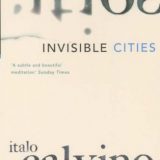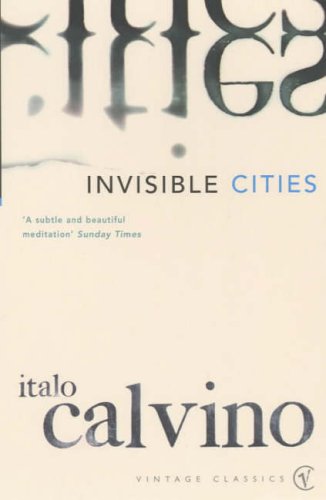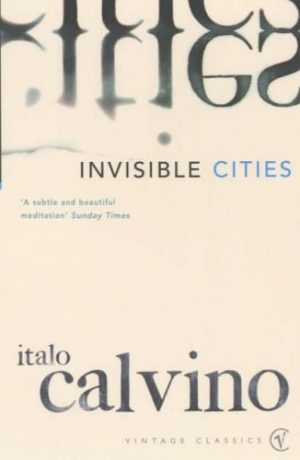Invisible Cities – Italo Calvino – 1972
Posted by Hanh on 3/3/2004, 6:45:44
The discussion seeds for Invisible Cities follow. This is the standard disclaimer to remind you that my literary interpretations have been known to be plein-de-crap, especially during their most cogent arguments and defense of position.
I claim to like this book. I do not claim to understand it whatsoever. My interpretation of these dreams, as that’s what they appear to me, are simply best guesses at a phantasmagoria of wild images which my reading bones insist must have some cohesion though whatever it is, it is maddeningly escaping me. I can only catch the glimpses, and my head still hurts from all that thinking.
So, dear friends, I hope that if my ramblings to follow do not bring insight, at least they will not be boring.
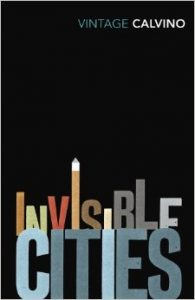
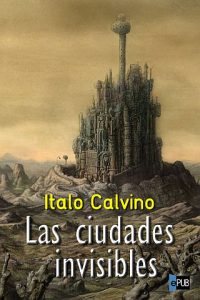

Posted by Hanh on 3/3/2004, 6:49:47
NOVEL STRUCTURE
The man-made structure of cities are allegorized in the structure of the chapters themselves. I find this parallel fascinating.
Note that the numeric sequences of the sub-chapter Numbers follows a simple but elegant mathematical sequence and the computer concept of “shift” to introduce new elements.
When mapped to such a non-mathematically thing as a novel, this approach is subtly exquisite in its creative symbolism.
Check out the Table of Contents: In Chapter 1, new numbers are brought in through a pattern of entry from the left. Chapters 2-9 are stabilized. In Chapter 9 (last chapter), numbers are eliminated through a pattern of exit from the right.
Chapter 1: 1 > 2, 1 > 3, 2, 1 > 4, 3, 2, 1 [left shift-in]
Chapter 2 through 8: 5, 4, 3, 2, 1
Chapter 9: 5 ,4, 3, 2, > 5, 4, 3 > 5, 4 > 5 [right shift-out]
The sub-chapter Description follows the same shifting pattern as the sub-chapter Numbers, but in reverse direction: instead of left shift-in, it uses right shift-in; instead of right shift-out it uses left shift-out.
Chapter 1: [right shift-in]
Cities and memory
Cities and memory, Cities and desire
Cities and memory, Cities and desire, Cities and signs
Cities and memory, Cities and desire, Cities and signs, Thin cities.
Chapter 2: [right shift-in]
Cities and memory, Cities and desire, Cities and signs, Thin cities, Trading cities
Chapter 3: [right shift-in] and [left shift-out]
Cities and desire, Cities and signs, Thin cities, Trading cities, Cities and eyes
Chapter 4: [right shift-in] and [left shift-out]
Cities and signs, Thin cities, Trading cities, Cities and eyes, Cities and names
Chapter 5: [right shift-in] and [left shift-out]
Thin Cities, Trading cities, Cities and eyes, Cities and names, Cities and the dead
Chapter 6: [right shift-in] and [left shift-out]
Trading cities, Cities and eyes, Cities and names, Cities and the dead, Cities and the sky
Chapter 7: [right shift-in] and [left shift-out]
Cities and eyes, Cities and names, Cities and the dead, Cities and the sky, Continuous cities
Chapter 8: [right shift-in] and [left shift-out]
Cities and names, Cities and the dead, Cities and the sky, Continuous cities, Hidden cities
Chapter 9: [left shift-out]
Cities and the dead, Cities and the sky, Continuous cities, Hidden cities,
Cities and the sky, Continuous cities, Hidden cities,
Continuous cities, Hidden cities,
Hidden cities
The man-made-ness of cities are juxtaposed in the structure of mathematics, another man-made construct.
Additionally, the idea of evolution of cities are maintained in the sequence — there are new cities that emerge (shift-in) and old cities that die away (shift-out), but there remains essentially continuity and interrelatedness between cities that already exist.
Is this not exquisite? Poetry in motion.
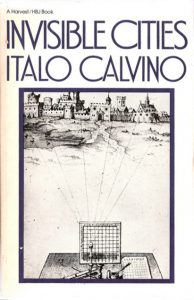
Posted by Lale on 3/3/2004, 16:22:43
This is amazing. One of the French teachers at the Sorbonne had told us to look at a text the way you would look at a painting. I think you have done just that, Hanh. He had told us that sometimes just by looking at the text you could “see” things (without reading). “Turn the text upside down if necessary”, he had said. And to demonstrate his point he stuck a vignette by Georges Perec upside down on the blackboard. Since then I have found I get more of the written word if I not only read it but also look at it.
Lale
Posted by Rizwan on 3/3/2004, 18:13:18
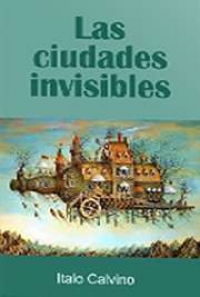
Even if I were to read this book a hundred times, I doubt I ever would have picked up on this. Thanks, Hanh. Brilliant observation.
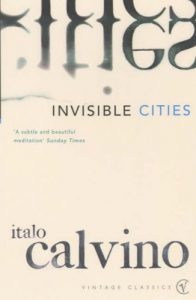
Posted by moana on 5/3/2004, 8:07:10
You know that there’s a pattern when Calvino talks about “the tracery of a pattern so subtle it could escape the termites’ gnawing.”
So there you have it. You’re more attentive than a termite :).
~moana
Posted by Hanh on 6/3/2004, 8:45:02
Gnaw, gnaw. 🙂 But let’s not over-estimate the reality of any attentiveness on my part. I still am very at sea with many if not most of the passages. It’s like waking up from a strange and vivid dream, where I wish I could understand what it all really meant. The best I can do is guess.
I’m reading Swan in Love (Proust) at the same time, and boy is it a joy to go back to straight forward and simple stream of consciousness. 🙂
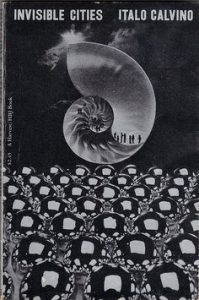
Posted by Hanh on 3/3/2004, 6:53:04
WHAT ARE CITIES?
Cities are the quintessential artificial human structure. They have become our necessary Inferno — they are our Enfants Terribles.
“The inferno of the living is not something that will be; if there is one, it is what is already here, the inferno where we live every day, that we form by being together.”
There are 2 ways to: ignore its horrors (make them invisible), so seek among the ruins the beauty that makes living worthwhile, and nurture them.
“There are two ways to escape suffering it. The first is easy for many: accept the inferno and become such a part of it that you can no longer see it. The second is risky and demands constant vigilance and apprehension: seek and learn to recognize who and what, in the midst of the inferno, are not inferno, then make them endure, give them space.”
DIMENSIONS OF CITIES
Cities, like humans, have 2 dimensions: physical and ephemeral, and exist within 2 levels of existence: micro (individual) and macro (humanity).
Physical: The physical aspects are tangible and easy to collate: landmarks, buildings, size, population, activities. Each vignette in the book contains some physical description of each city.
Ephemeral: The ephemeral aspects include intangibles such as history, events, and time, which serve indistinguishable roles in defining a city.
“I could tell you how many steps make up the streets rising like stairways, and the degree of the arcades’ curves, and what kind of zinc scales cover the roofs; but I already know this would be the same as telling you nothing. The city does not consist of this, but of relationships between the measurents of its space and the events of its past. … A description of Zaira as it is today should contain all Zaira’s past.”
At the micro level, cities are composites of individual lives, and the conglomeration of their memories, desires, dreams, reality, triumphs, failures.
At the macro level, they are reflections of Humanity as a single entity. Cities, like Humanity, are more than the sum of their parts. The greatness of cities (humananity) lies our perception of its greatness. Its ruin is our perception of its ruination.
The glory of Rome was built on the ruins of many civilizations.
“There is a sense of emptiness that comes over us at evening, with the odor of the elephants after the rain and the sandalwood ashes growing cold in the braziers … It is the desperate moment when we discover that this empire, which had seemed to us the sum of all wonders, is an endless, formless ruin.”
At the micro level, the truth of cities (and of our individual existence) has meaning only at the individual level: what does this city mean to me? Hong Kong is not for millionaires the same city as for the janitors servicing her buildings. Likewise, we can also ask, what does this life mean to me?
“if for eight hours a day you work as a cutter of agate, onyx, chrysoprase, your labor which gives form to desire takes from desire its form, and you believe you are enjoying Anastasia wholly when you are only its slave.”
At macro levels, cities are reflections of Humanity, an indistinguishable ebbing mass, in which the single individual has little significance.
Individuals are stones in the arch of Humanity. They make up Humanity, but paradoxically, once we speak of Humanity as a singular entity representing all individuals, the individual is lost.
“Marco Polo describes a bridge, stone by stone.
‘But which is the stone that supports the bridge?’ Kubali Khan asked.
‘The bridge is not supported by one stone or another,’ Marco answers, ‘but by the line of the arch that they form.’
Kublai Khan remains silent, reflecting. Then he adds: ‘Why do you speak to me of the stones? It is only the arch that matters to me.’
Polo answers: ‘Without stones there is no arch.'”
I think one of the unsolvable ethical problem of man lies in the unbridge-able divide between Personal Policy and Social policy, — between the stone and the arch. As a personal policy: my child should be saved at all costs. As a social policy: not all children should be saved at all costs.
I think Cities are fabulist allegories of human existence, of the human condition.
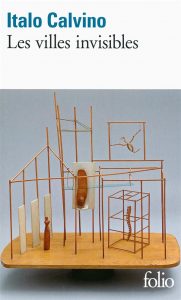
Posted by Lale on 4/3/2004, 1:16:35
City names are either feminine or possibly feminine. I thought about the fertility of cities. Like the mother in “mother nature”.
Diomira
Isidora
Dorothea
Zaira
Anastasia
Tamara
Zora
Despina
Zirma
Isaura
Maurilia
Fedora
Zoe
Zenobia
Euphemia
Zobeide (Zübeyde – Turkish and other languages in the region)
Hypatia
Armilla
Chloe
Valdrada
Olivia
Sophronia
Eutropia
Zemrude (Zümrüt – Emerald in Turkish)
Aglaura
Octavia
Ersilia
Baucis
Leandra
Melania
Esmeralda
Phyllis
Pyrrha
Adelma
Eudoxia
Moriana
Clarice
Eusapia
Beersheba
Leonia
Irene
Argia
Thekla
Trude
Olinda
Laudomia
Perinthia
Procopia
Raissa
Andria
Marozia
Penthesilea
Theodora
Berenice (unjust city)
Posted by Hanh on 3/3/2004, 6:58:39
HOW ARE CITIES INVISIBLE?
1. In one allegorical sense, cities are Invisible because for being so physical, they are elusive, un-seeable, undefinable. As we describe them in words, they lose the ethereal nature that defines them for us.
“‘Memory’s images, once they are fixed in words, are erased,’ Polo said, ‘Perhaps I am afraid of losing Venice all at once, if I speak of it. Or perhaps, speaking of other cities, I have already lost it, little by little.'”
Even those who live in a city cannot explain its true essence — they can only explain what it means to them. How do Parisians explain Paris to foreigners?
“Kublai asks Marco, ‘When you return to the West, will you repeat to your people the same tales you tell me?” “I speak and speak,” Marco says, “but the listener retains only the words he is expecting. … It is not the voice that commands the story: it is the ear.'”
Cities must be experienced, as life must be experienced.
Ultimately, a city is in the eye of the beholder. It is our perception which renders meaning to the city, and allegorically, to the circumstances of our own existence.
“For those who pass it without entering, the city is one thing; it is another for those who are trapped by it and never leave. There is the city where you arrive for the first time; and there is another city which you have never to return. Each deserves a different name.”
2. In a mathematical sense, I think cities are Invisible because we cannot physically see all their possibilities in all dimensions.
In quantum mechanics, each possibility is a fully fleshed-out reality, but only one is experience by the observer. All other reality pathways, are invisible to us because we live in a sequential dimension.
“The Great Khan owns an atlas whose drawings depict the terrestrial globe all at once … the atlas depicts cities which neither Marco nor the geographers know exist or where they are, though they cannot be missing among the forms of possible cities”
3. In the most intriguing sense however, I think cities are allegories for our own lives, for the pathways/situations through which each person’s life travels. Like cities, life’s pathways also has endless possibilities, of which we can experience only one.
“Marco enters a city; he sees someone in a square living a life or an instant that could be his; he could now be in that man’s place, if he had stopped in time, long ago; or if, long ago, at a crossroads, instead of taking one road he had taken the opposite one, and after long wandering he had come to be in the place of that man in that square. By now, from that real or hypothetical past of his, he is excluded; he cannot stop; he must go on to another city, where another of his pasts awaits him, or something perhaps that had been a possible future of his and is now someone else’s present. Futures not achieved are only branches of the past: dead branches.”
To the extent that we become indifferent to things around us, those realities become invisible to us. Cities, as allegories of the realities surrounding our experience, are thus said to be invisible to us if we become indifferent to them.
“‘Happy the man who has Phyllis before his eays each day and who never ceases seeing the things it contains,’ you cry. … But it so happens that, instead you must stay in Phyllis and spend the rest of your days there. Soon the city fades before your eyes … All the rest of the city is invisible. Millions of eyes look up at windows, bridges, capers, and they might be scanning a blank page. Many are the cities like Phyllis, which elude the gaze of all, except the man who catches them by surprise.”
For me, the city is an allegory of our lives in full dimensions. It has a micro view of individuals as singular beings, a macro perception of Humanity as a mass entity, and all shades of experiential complexities in between. Often, we do not understanding them — the truths of our own existence is invisible to us.
“The city does not know that its only moments of generous abandon are those when it becomes detached from itself, when it lets go, expands.”

Posted by Rizwan on 3/3/2004, 19:40:50
I probably would never have thought of #2, but surely you are correct in this, Hanh.
#1 is definitely true: I’ve tried to explain places like Paris and San Francisco to people who have never been there, and I am simply unable to do these cities justice. BTW: Same goes for great works of art, which certain cities (like Paris and San Francisco) resemble, in a sense. I recently tried to explain what it is about “Don Quixote” that is so great to someone who had never read it, and I felt like an idiot, to the point where I started questioning how I myself could love this work so much when I can’t even express fully and convincingly why this is so! Same thing happened when I attempted to explain my ongoing fascination with Proust to an acquaintance of mine: I just couldn’t do it, and so that acquaintance ended up asking me: “Well, what’s so great about that?”
#3 is, I think, the closest to what Calvino was getting at in “Invisible Cities”–the city of our imagination as allegory for the life we have lived. Just as with the city of Zaira, “a description of (our life) as it is today should contain all (our) past.”
Borges, I think, addressed this idea too, in his story “Pierre Menard, Author of the Quixote,” where Menard sits down centuries after Cervantes to try to re-write the story of Don Quixote word for word. But in order to do so most convincingly and completely, he realizes he must first try to have every aspect of his life mirror that lived by Cervantes, right down to the battles he fought.
I would like to add a fourth possible explanation of invisible cities, however. It is somewhat related to what you’ve already written, Hanh, especially to #1. I think cities are invisible to the extent that they are invisible to others, not to ourselves. We have a tangible idea of what a certain city is in our mind, and for us, well, we can picture it easily. But that same city of my imagination is not the one that you have; for you, my city is, in essence, invisible. We can both think of and describe the same city, but my image of it–and what this image means to me–will never be exactly what yours is; it may not even be similar.
Calvino speaks to this when he writes: “This city which cannot be expunged from the mind is like an armature, a honeycomb in whose cells each of us can place things he WANTS to remember.” What I want to remember (consciously or otherwise) will inevitably be different in many ways, will be filled with different meaning, from what you will want to remember, even if we are remembering the same thing, say a specific street in New York, for example.
Then later, in another chapter, Calvino follows this up by saying: “Memory is redundant: it repeats signs so that the city can begin to exist.” Exist for whom? Only for ourselves. As each person’s memory of these signs will be different, so too will be the city s/he has created.
As I said, though, I’m still working my way through the book, so it could be that all of what I’ve written above is hogwash.
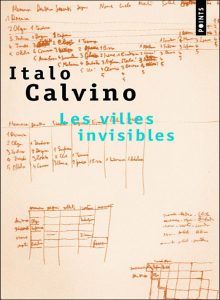
Posted by moana on 5/3/2004, 8:10:47
OK, so when he starts the first chapter, it begins
“Leaving there and proceeding for three days toward the east…”
Leaving where? Kublai’s palace? Perhaps the last city of the book? Is this a circular novel?
~moana
Posted by Hanh on 6/3/2004, 8:41:23
I don’t think those statements are reflective of actual places. All descriptions are dream-like on purpose. We do not know if those places really exist in our physical reality, although they exist as “alternate realities” in a multi-dimensional matrix. Like our existence, reality is fluid. In addition, time and space are not fixed in the description of “citites”, so I think that sentence is simply “fillers words” by way of introducing the concept that follows.
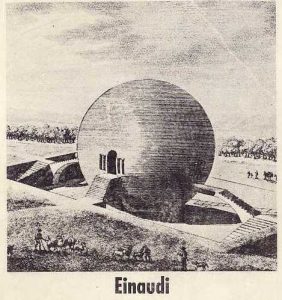
Posted by len. on 10/3/2004, 19:51:26
Rizwan writes:
>BTW: Same goes for great works of art, which certain cities (like Paris and San Francisco) resemble, in a sense.
This is also true of great music. I used to try to explain to friends why they should come to a concert with me to hear a great work in live performance, by trying to “describe” the work. Now I just say “trust me, you want to have experienced this”.
len.
Posted by Hanh on 3/3/2004, 6:56:05
CONCLUSION:
I think this book is classic Calvino, where whole is always more than the sum of its parts. I enjoy it the same way I enjoyed “Invitation to a Beheading” — because everything is said in things unsaid.
However, I do not claim to understand most of it. To me, the vignettes are like strange Freudian dreams open to endless interpretations, but some parts are so bizarre that they escape all reasonable guesses. So I would have to leave them at that, and move on to the parts that do make sense. I think Calvino not only would allow, but preconceived this.
“The descriptions of cities marco Polo visited had this virtue: you could wander through them in thought, become lost, stop and enjoy the cool air, or run off.”
A best part of this book, to me, remains the enticement for the readers to add life to the interpretation, to build his own cities. It is frustrating at times (as wandering around blindly can be), and the exercise of making sense out of phantasmagoria can be exhausting, but where there are glimpses of things that DO make sense, it is a treat for the mind.
“At times all I need is a brief glimpse, an opening in the midst of an incongruous landscape, a glint of lights in the fog, … and I think that, setting out from there, I will put together, piece by piece, the perfect city”
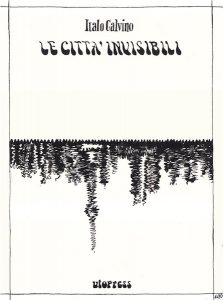
Posted by Rizwan on 3/3/2004, 18:32:13
Hanh, thank you for your amazing posts! Short as it is, I am not nearly through with the book as yet–I am reading it slowly, taking notes, trying to “get” what Calvino is getting at. I have to say, though: I agree with nearly everything you’ve written, only you’ve said it far more eloquently and clearly than I ever could. I will use your posts as a guide through the rest of the book, and probably to help get me through future readings, too, as I feel this is one of those books that deserves, even demands, multiple readings.


